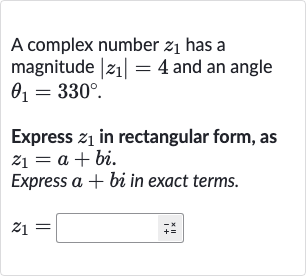Full solution
Q. A complex number has a magnitude and an angle .Express in rectangular form, as .Express in exact terms.
- Convert angle to radians: To express a complex number in rectangular form given its magnitude and angle, we use the polar to rectangular conversion formula: , where is the magnitude and is the angle in radians. Here, and .
- Calculate radians: First, convert the angle from degrees to radians because the trigonometric functions in the formula require the angle in radians. The conversion formula is . So, .
- Substitute values into formula: Calculating the radians: radians.
- Calculate trigonometric functions: Now, substitute and into the polar to rectangular conversion formula: .
- Simplify expression: Calculate and . From the unit circle, we know that and .
- Simplify expression: Calculate and . From the unit circle, we know that and .Substitute the values of and into the formula: .
- Simplify expression: Calculate and . From the unit circle, we know that and .Substitute the values of and into the formula: .Simplify the expression: .
More problems from Find the inverse of a linear function
QuestionGet tutor help
QuestionGet tutor help
QuestionGet tutor help
QuestionGet tutor help
QuestionGet tutor help

